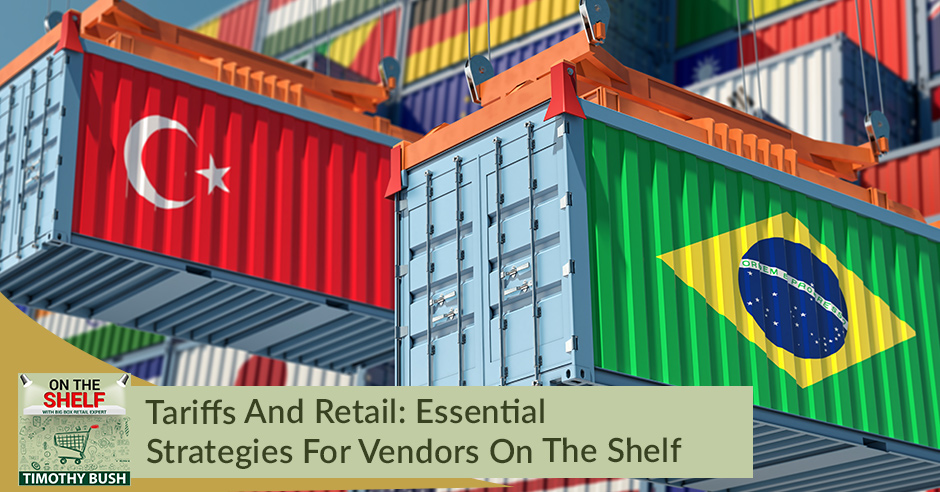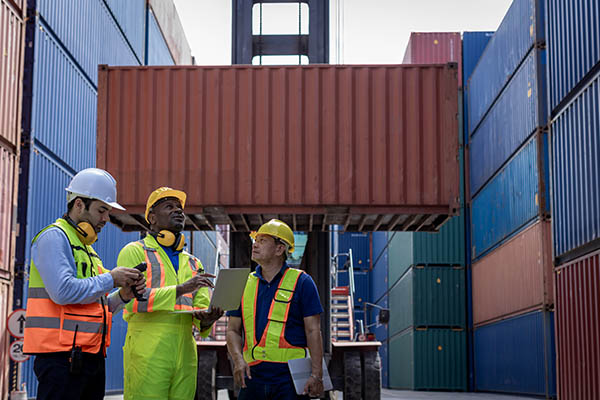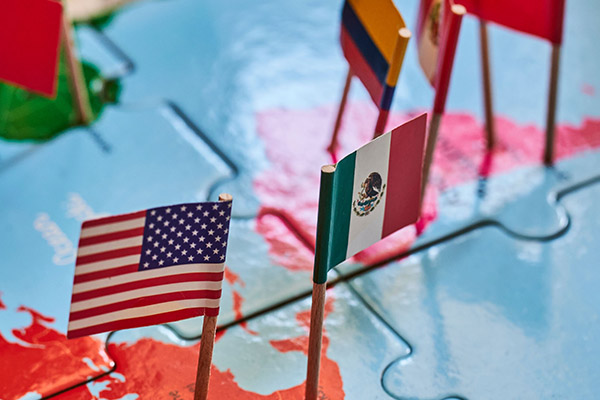
Welcome back, big boxers! It’s been a while, but we’re back to guide you through the ever-evolving world of big box retail. Even after a hiatus, the demand for clear, actionable advice on getting your products into major retailers remains immense. And who better to offer that guidance than someone still in the trenches, making deals and navigating the shifting retail landscape every single day?
In this much-anticipated return, Tim Bush dives deep into a topic that’s on everyone’s mind but rarely in the headlines: tariffs. While it might seem like an old issue, retailers and manufacturers are now truly grappling with the real-world impact. We’ll break down the four key strategies you need to master when discussing tariffs with your buyers, ensuring you’re prepared, professional, and proactive in these uncertain times. Plus, a crucial bonus tip on why you should always have a backup plan. Don’t wait and see—learn how to thrive in the new retail normal!
—
Listen to the podcast here
Tariffs And Retail: Essential Strategies For Vendors On The Shelf
It has been a while. It’s been a long time. It has been years. I decided that I wasn’t going to go forward with this show anymore because I said everything that I needed to say. I found out that this show still gets a tremendous amount of downloads per month, even though I haven’t posted an episode for maybe three years. There are still a lot of people out there who need help, wanting to know what the key things are to help them get into a major big box retail. I thought, “Why not start it up again?”
The Resurgence Of The Podcast & Evolving Retail Landscape
A lot has changed since COVID. Unlike other consultants who help people get into retail, I am still selling into retail every single day. I’ve put products into Dick’s Sporting Goods, Academy Sports, and Canadian Tire. We locked down a mod change for 2026 for Walmart. I’m still very much in the trenches of working with retailers, getting products into retail, and helping manufacturers understand and solve the big dilemma of, “Should I go? Do I need to go? Do I need to be in retail? If so, how do I do it? What are the key things they need to watch out for?”
All those things are still on the minds of people wanting to place a product on a shelf of a major retailer. They’re all still valid, although the retail landscape has changed tremendously. It’s not the same retail landscape that it was pre-COVID. It’s not even the same retail landscape that it was, pre-new administration. There are constant changes, constant roadblocks, and hurdles.
Addressing Tariffs With Retailers: A New Reality
People are wondering, “Is retail dead? Is it going to still be viable? Do I need to put money, time, and effort into getting my products there?” I’m back to answer all those questions and more. In this episode, I wanted to start with something that’s probably on the tip of everybody’s tongue, which is tariffs. I know it seems like an old topic. We don’t even notice that tariffs are still getting imposed on different things every single week. It’s not in the news.
However, retailers are starting to deal with the ramifications of tariffs because most vendors are out of the product that they had pre-tariff. Maybe they had loaded in products, and those products have sold through. Retailers are dealing with manufacturers that are saying, “The same product that I sold you last month now is going to be a different price.”
I was speaking to a buyer at Costco who normally would be getting back to me quickly. I sent him an email, and normally, he would get right back to me, but it was weeks. Finally, he got back and said, “I’ve been buried doing price changes due to tariffs.” That’s a reality. It’s a reality of our new environment. It’s a reality of how we’re going to do business, at least for now. It’s a reality for how you have to start communicating with buyers. It’s a reality of how you need to start working on your pricing, how tariffs affect you, and whether it is better to start looking at secondary factories.
I have a coaching client who, before the tariffs were even in place, I sent him to Cambodia to get set up with an entirely new factory. He did that, and then the next thing you know, there were tariffs on Cambodian goods. That ended up not being as viable as we thought. Still, it was his proactiveness at the time when he was talking to Walmart and they were asking him, “What are you doing?”
Him saying, “I was in Cambodia talking to factories there about moving some of my production there,” went a long way with Walmart. In a sea of vendors saying, “I don’t know. I’m going to wait and see,” and being paralyzed, he was taking action. That meant a lot to the buyers, because it may not seem like it, but these buyers are being hammered from all directions on how they’re going to deal with it.
At the beginning, we thought, “This isn’t going to last. This is a scare tactic,” or, “This is leverage,” but it’s turning out to be a long-term thing. You either do 1 or 2 things here. You either figure out how to live within it, or you fold. The people that I work with, we stopped saying, “Let’s wait again. Let’s wait and see what happens. Let’s wait and see if things smooth out.” We stopped doing that. Even though things did smooth out a little bit, we stopped waiting for it and started saying, “This is the reality we’re dealing with.” We started having open and honest conversations with our retailers so that everybody was prepared.
That’s what I want to talk about in this episode. This is not going to be a long episode. This is the first one back, so I’m going to hit these topics, set you in motion, and give you something to think about if you are having conversations with your retailers about tariffs. I broke it down into the top four things that I coach my clients on when they’re about to have these conversations with their retailers on tariffs. Let’s get into it with number one.
Strategies For Tariff-Based Price Changes: Dispelling Myths & Navigating Norms
I want you to know that the tariffs are not your fault. You didn’t do it. You didn’t say to do it. Maybe you voted for it, and that’s fine, but it’s still not your fault. You’re not responsible for it. However, what I find is when one of my clients sends me, “I’m going to send this email to so-and-so retailer about our tariffs. Can you look over it and let me know what you think?” One of the very first things in the email is, “I’m sorry.” They’re like, “I’m sorry that we have to do this. I’m sorry, but I’m going to have to reprice you. I’m sorry that these things are happening.”
The tariffs aren’t your fault. You didn’t cause them or ask for them. Click To TweetYou don’t need to be sorry. When you say you’re sorry, it makes it seem like you’re doing something to them that you have control over. You could not do it. You’re like, “I am sorry you got to do this. I’m sorry that this is happening, but I have no other choice.” You make it seem like you are, in some way, in control of this happening. Therefore, because you’ve chosen to impose this new pricing, you’re sorry, but you’re going to do this.
Maybe you’re empathetic to it, but you don’t need to be sorry. I would recommend that you not use that tone in the email or the conversation. What you need to say is, “As you know, the products that we sell you now have a tariff. I wanted to get with you as soon as I possibly could on our new pricing based on this new reality. Our current pricing is this. With the new tariff, it’s now this.” That’s it. It’s not something that you can say, “I’m sorry. This is what we have to do.” You should say, “This is what it is. The tariffs are X. My price is Y. X plus Y equals Z. Here you go.”
Even though you might be sorry that the whole thing is happening, you don’t need to talk to your buyer like that. You need to keep it professional. You need to keep it business. This is a business thing. It’s not ambiguous. The tariffs are not a range. If you have a certain product and it has a certain tariff, you can’t simply ignore that.
I know that there’s all this out there, like, “Absorb it. Do this.” You know as well as I do that we can’t absorb it. If there’s a 25%, 30%, 40%, or 50% tariff on your product, somebody has to absorb that. Maybe you can talk to your factory. They can absorb a little bit of it. Maybe you can absorb a little bit of it, and then the consumer is going to absorb the majority of it.
That’s the big mystery around tariffs. It’s like, “We’re sticking it to this person or that person.” The people who are getting stuck with it are the people who are buying the product. There’s no way to get around it. You can’t up a product 50% or 40% and expect that you somehow magically had 50% or 40% extra margin in your product that you could be like, “I’ll take that.” We all know that’s not true.

When you’re talking to your buyer in some dry conversation, it’s the reality of it. It’s like, “Here’s the price we were at. Here’s the tariff. Here’s the price that we’re now at. We’re not trying to make any extra money. We’re not adding any extra margin in there for us because we have to somehow absorb something else. We’re passing on this margin to you, and you, at some point, are going to have to pass it on at the retail price.” No matter how bad you feel about it, it’s not your fault. You don’t have to act like it’s your fault. You don’t have to talk like it’s your fault. You certainly don’t have to apologize for something that you didn’t do. You weren’t necessarily a part of how it came to be, so talk to them about the reality of it.
Number two, tariffs, coming out the way they have, doesn’t conform to the norm. I’ll give you an example. I have a client that we sell to Tractor Supply. When we went to them and gave them the new pricing, they said, “You know that we have a 60-day window. You need to give a 60-day notice that the pricing is going to change.” Our response to that was, “Understood. Had we been given 60 days’ notice, we would’ve been able to give that to you. Since we were given a day’s notice, that’s the reality of what we’re living in right now.
I understand that you have a policy, but we’re living in different times. We’re living in changing times. Therefore, in order for us to continue to keep your product online and in-store on new products coming out, we have to implement this pricing right now. We have a product on its way over that we’re expecting to sell to you, and it’s going to be imposed these new tariffs. Either we stop it from coming onto your website or into your store and wait 60 days, or we pull the trigger on these price changes and do it the best way that we can.”
I get it. Retailers are reeling. They’re reeling left and right. People are coming to them with price this and price that. Nobody wants to up their prices, but we can’t hide it either. We need to understand the reality of tariffs and how they affect things. We can’t hide it. We can’t say it doesn’t exist. We can’t say that it’s not real or that there’s plenty of margin out there for everybody, and we’ll absorb it. Those of us who are in the trenches of retail, pricing, and margin understand that’s not true.
Nobody wants to raise their prices, but we can’t ignore it either. We need to understand the reality of tariffs and their impact. Click To TweetThe norm is not always going to work. Every retailer has a price change policy. Otherwise, people would be changing prices every week. We know that you have that. Not to worry, but this is not the norm. We’re not changing prices because it’s a new year and we want to make more money. We’re not changing because the cost of goods has gone up, so this year, we’re making our normal biannual price change. That’s not what this is. This is a tariff-based price change that needs to be implemented right away. Therefore, you are going to have to make an exception to this 60-day rule.
Understand that when you try to make this change, saying, “Here is the new pricing,” they are going to push back and say, “There’s a window. There’s a lead time that we need.” You’re going to have to go back to them with that same strategy that we did, which is, “Understood. I get that you have rules, but we’re under different situations, different pressures, and different timeframes. These tariff-based price changes can’t wait.” I would encourage you to talk to them about it like that.
Number three, these price changes could change again. These tariffs are constantly up for review and could change. What we’ve been saying is, “This is your new pricing based on current tariff rates. If the tariffs go down, then we are going to price you back down. If the tariffs go up again, we may have to reprice you again.”
It’s important that you let them know this is based on current. Refer back to number one. These are not your fault. You’re not doing it. You’re not imposing it. If we wake up tomorrow and the tariff that was 30% turns into 40%, guess what? We can go through the current products that we have and work through those at the current tariff rate, but once those are gone and we’re bringing in new products, it’s going to be re-priced.
It’s better to get that out in front. It’s better to get that out in the open rather than try to wait until it happens and then try to push it through at the last second. I’m not saying that we lament on it. All I’m saying is that when you talk about the pricing, it’s based on current tariff rates. Number three is that they could change again. It’s not a bad thing to say, “These are based on current tariff rates.” You don’t even have to say, “They could change again. Let’s keep an eye out.” You’re telling them, “This is based on current.” They know when tariff rates change. They’re very aware of that.
Number one, it’s not your fault. Number two, these changes don’t conform to the norm. It’s going to be outside your current normal procedures or the retailer’s procedures. Number three, it could change again. Make sure that you let them know that these price changes are based on current tariffs. It’s not the future or yesterday’s, but the current. They’ll understand that that means that things could change.
Last, you’re not alone. It’s not just happening to you. You’re not the only conversation that the retailer’s having about this, even though they might make you think or make you feel like, “Everybody else is absorbing this. You’re the only one on the planet that’s asking for a price change.” That’s not true. Take it from me. I’m talking to these buyers all the time, and that’s all they’re concerned with. All they’re dealing with is price changes. You’re not alone. Don’t make anybody make you feel like you’re the only one struggling with this issue. It’s happening to everybody across the board.
When you’re dealing with retailers, those are the key four things I want you to keep in mind. Number one, it is not your fault. Number two, we’re outside the norm. Number three, prices could change again. Number four, this isn’t just happening to you. No matter what they say to you or make you feel, it’s not just an issue happening to you.
Proactive Measures & Future Preparedness
As a bonus, this is some advice. It’s always good to have backup factories or backup manufacturing. Even though maybe things have stabilized a little bit and you feel pretty comfortable with what’s going on in your factory, your tariffs, this or that, don’t sit on that. Always be looking for other countries, other factories, and other options, even here in the States or wherever you are. Don’t sit because things could change again.
As I said early on in the talk, when we told Walmart that my coaching client was already in Cambodia talking to other factories, they were like, “That’s great.” Even though that didn’t turn out to pan out, he still has those factories set up. At some point, if China gets imposed more tariffs and Cambodia has less, that situation is done. He can switch that manufacturing over to the Cambodian factory like that.
That gave Walmart a couple of things. One, it gave them the confidence that this particular vendor is being proactive, not reactive. They’re being proactive, not neutral. That’s what they need. Two, it elevated him in their standings because they understand that he’s doing that for them. He wants to keep his products flowing.
Also, we have to keep our buyers in mind. Making our buyers look good is what keeps them buying our products. If we can give them ammunition to tell their bosses, “These guys have already sourced other factories. They’re making moves,” that makes them look good. It’s like, “You’re already talking to your vendors about this.”
I know it’s been a long time since you’ve heard from me, but if you’re a long-time reader, you know that I am not a fan of wait and see. I’m not a fan of being neutral. You’re either moving forward or you’re falling behind. During COVID, the conversations that we were having were that a lot of clients were pulling back. They were like, “I’m going to wait and see.” Those people are non-existent anymore.

The ones that waited to see didn’t make it. It was the ones who pushed forward and figured out something new. It was the ones who figured out what customers needed, changed their product, changed their strategy, went online, and went into delivery. Whatever it was, they decided to participate in the new normal, not wait and see if normal came back. This is no different. Every day is a new normal. You participate in it and push forward with it. Even if you get knocked down, you get up and keep pushing forward. If you play wait and see, every day, you’re getting further behind.
It is so good to be back with you. Hopefully, this helped. It’s hard when you’re dealing with tariffs or anything like this, especially with pricing and having these conversations with your buyers. Take the emotion out of it. Make sure this is a professional discussion. People understand business. The sooner you have the conversations, the better. Don’t wait until the end. Don’t wait until saying, “Product is showing up tomorrow, and I need to add X amount of money to it.” That’s not going to help your buyer. They can’t turn on a dime. They can’t make changes lickety-split.
They’re like the Titanic. If you’re dealing with Walmart, it’s ten times the Titanic trying to turn the ice from the tariff iceberg. It’s like if you found out that you had a shipment that was going to be late and you’re like, “Maybe they’ll catch a tailwind on the water and it will pick up in a couple of days.” You always let the buyer know the second you find out that something might be late because it gives them time to maneuver. If you give them no time, a lot of times, that’s going to bite you.
A lot of great things are happening. TLB is getting ready to launch a brand-new group about getting into retail. It is a bunch of people getting together who have products in retailers and looking to expand that. There is no better place to be than with other people doing the same thing that you’re doing, dealing with the same struggles that you’re dealing with, and bouncing things off.
We’re getting that group up and running. Most likely, it’s going to kick off the 1st week of November 2025. If you’re interested in that, you can always email me or shoot me a message. I’m happy to send you the details on that. I hope that in my absence, you’ve been prospering. I hope that your products are out there, on the shelf, and doing well. I hope that you and your families have been safe and have prospered during this time. I look forward to more frequent conversations. Until then, I look forward to seeing your products on the shelf.
Important Links
- Timothy Bush on LinkedIn
- Timothy Bush on Instagram
- On The Shelf: How To Get Your Products Into Big Box Retail! on Apple Podcasts
